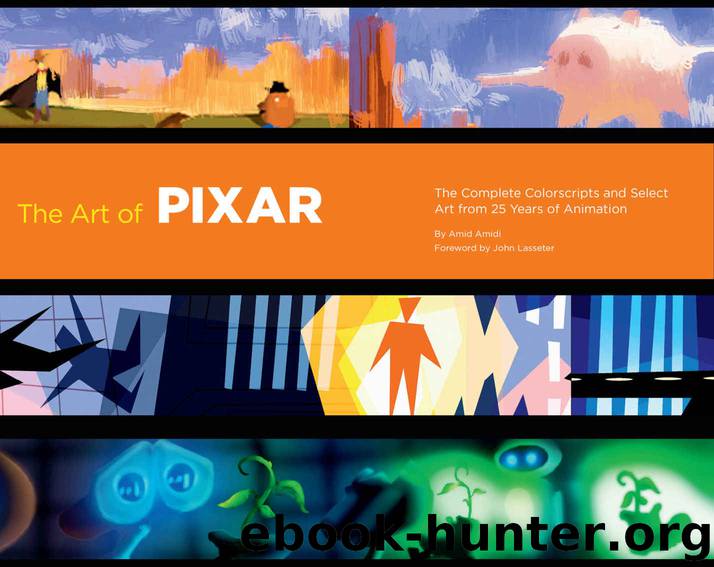The Art of Pixar by Amidi Amid

Author:Amidi, Amid
Language: eng
Format: epub
Publisher: Chronicle Books LLC
Published: 2015-11-02T16:00:00+00:00
More recently, Pixar has turned to a younger generation of artists to create colorscripts: Lou Romano (b. 1972) created the colorscripts for The Incredibles and Up, while Dice Tsutsumi (b. 1974) was responsible for scripting Toy Story 3. Romano was a natural choice to create the colorscripts for The Incredibles. His first job in visual development had been on Ray Gunn, an unmade film that The Incredibles director Brad Bird had developed in the mid-’90s. Later, Romano helped Bird create pitch artwork for The Incredibles while he was still working on The Iron Giant.
Romano created three very different versions of the colorscript for The Incredibles, each distinct in style and tone, before he considered the job to be finished. The evolution of his thought process is fascinating to see. His first script, from 2000, was painted in gouache and is a fairly static representation of individual settings and characters. The transitional colorscript was created with a combination of gouache and digital illustration. The sixty horizontal panels contain multiple scenes, reflecting how the story has been fleshed out in the intervening years. His saturated palette is joyous, its tone almost too happy for the story being told. The final colorscript, finished in 2004, was drawn digitally into the computer, a first at Pixar. Romano’s assertively large fields of solid color unveil a superheroic Matisse. Juxtaposed against punchy colors are stark areas of black and white. His riveting, high-contrast approach to color, which were faithfully recreated in the film to the extent that computer animation allows, reinforces the adventurous and dramatic elements of the story in pure color.
The colorscript for Toy Story 3 painted by Tokyo-born artist Dice Tsutsumi follows in the painterly footsteps of Bill Cone, albeit painted digitally. Tsutsumi’s first job out of the School of Visual Arts was at Lucas Learning, during which time he saw a lecture by Bill Cone about colorscripting. “I became interested in colorscripting after seeing Bill’s work,” Tsutsumi said. “His attention to light and color has influenced me more than anyone in the business.”
Prior to arriving at Pixar, Tsutsumi worked at Blue Sky Studios on the East Coast. The colorscript he created for Horton Hears a Who! is among the more unconventional examples of the form. Tsutsumi infused certain colors with meaning specific only to the film. So, pink became the unlikely embodiment of devastation, and during Horton’s climactic third act, the entire palette is driven by pink, magenta, and violet before shifting to yellow (a complementary color to the others) as the film reaches its happy resolution.
Tsutsumi continued this unique approach of associating emotions with specific colors when he began working at Pixar. In Toy Story 3, the color blue has special significance. The film’s director Lee Unkrich explained, “We came up with the concept of blue connoting safety and home. At the beginning of the film, Andy . . . his bedroom is blue, the sky is blue, his T-shirt is blue. He is in blue jeans, he’s got a blue car—these are not accidents.
Download
This site does not store any files on its server. We only index and link to content provided by other sites. Please contact the content providers to delete copyright contents if any and email us, we'll remove relevant links or contents immediately.
| Coloring Books for Grown-Ups | Humor |
| Movies | Performing Arts |
| Pop Culture | Puzzles & Games |
| Radio | Sheet Music & Scores |
| Television | Trivia & Fun Facts |
The Kite Runner by Khaled Hosseini(5133)
Gerald's Game by Stephen King(4607)
Dialogue by Robert McKee(4353)
The Perils of Being Moderately Famous by Soha Ali Khan(4194)
The 101 Dalmatians by Dodie Smith(3481)
Story: Substance, Structure, Style and the Principles of Screenwriting by Robert McKee(3419)
The Pixar Touch by David A. Price(3389)
Confessions of a Video Vixen by Karrine Steffans(3273)
How Music Works by David Byrne(3233)
Harry Potter 4 - Harry Potter and The Goblet of Fire by J.K.Rowling(3031)
Fantastic Beasts: The Crimes of Grindelwald by J. K. Rowling(3029)
Slugfest by Reed Tucker(2972)
The Mental Game of Writing: How to Overcome Obstacles, Stay Creative and Productive, and Free Your Mind for Success by James Scott Bell(2874)
4 - Harry Potter and the Goblet of Fire by J.K. Rowling(2683)
Screenplay: The Foundations of Screenwriting by Syd Field(2600)
The Complete H. P. Lovecraft Reader by H.P. Lovecraft(2528)
Scandals of Classic Hollywood: Sex, Deviance, and Drama from the Golden Age of American Cinema by Anne Helen Petersen(2491)
Wildflower by Drew Barrymore(2466)
Robin by Dave Itzkoff(2411)
